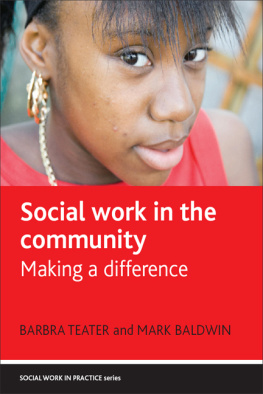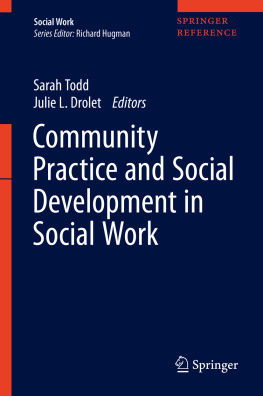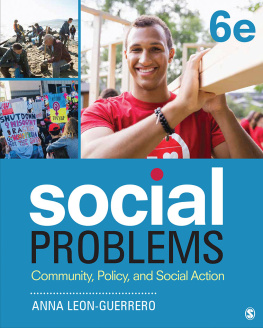First published in Great Britain in 2012 by
The Policy Press
University of Bristol
Fourth Floor
Beacon House
Queens Road
Bristol BS8 1QU
UK
t: +44 (0)117 331 4054
f: +44 (0)117 331 4093
tpp-info@bristol.ac.uk
www.policypress.co.uk
North American office:
The Policy Press
c/o The University of Chicago Press
1427 East 60th Street
Chicago, IL 60637, USA
t: +1 773 702 7700
f: +1 773 702 9756
sales@press.uchicago.edu
www.press.uchicago.edu
The Policy Press 2012
British Library Cataloguing in Publication Data
A catalogue record for this book is available from the British Library.
Library of Congress Cataloging-in-Publication Data
A catalog record for this book has been requested.
ISBN 978 1 84742 484 6 paperback
ISBN 978 1 84742 485 3 hardcover
The right of Barbra Teater and Mark Baldwin to be identified as authors of this work has been asserted by them in accordance with the Copyright, Designs and Patents Act 1988.
All rights reserved: no part of this publication may be reproduced, stored in a retrieval system, or transmitted in any form or by any means, electronic, mechanical, photocopying, recording, or otherwise without the prior permission of The Policy Press.
The statements and opinions contained within this publication are solely those of the authors and not of the University of Bristol, The Policy Press or the British Association of Social Workers. The University of Bristol, The Policy Press and the British Association of Social Workers disclaim responsibility for any injury to persons or property resulting from any material published in this publication.
The Policy Press works to counter discrimination on grounds of gender, race, disability, age and sexuality.
Cover design by The Policy Press.
Front cover: image kindly supplied by John Birdsall.
Printed and bound in Great Britain by Hobbs, Southampton.
The Policy Press uses environmentally responsible print partners.
Readers Guide
This book has been optimised for PDA.
Tables may have been presented to accommodate this devices limitations.
Image presentation is limited by this devices limitations.
Chapter 1: Introduction to social work in the community
Practice example 1: Hasan
Hasan is a social worker working in a community mental health team. He is very aware of the governments new personalisation and transformation agendas that emphasise choice, control, prevention and the building of social capital (DH, 2007). He is, however, very sceptical of this agenda as all he deals with are emergencies. One afternoon, while visiting a GP practice, Hasan gets into a conversation with Anna, a health visitor whom he has met before. They discuss the fact that most of their work is on one or two housing estates mainly owned by a social housing association. They agree that the problems they encounter are similar and note that a number of professionals (social workers, health visitors, community psychiatric nurses, GPs, etc) visit in order to deal with the individuals who live there. Hasan and Anna remember the parts of their professional education that touched on community practice, and wonder whether there is anything they can learn from that to improve the lives of people that live on the estate, individually or collectively. What might they come up with?

Practice example 2: Irene
Irene is a social worker at a Sure Start childrens centre situated in an ethnically diverse neighbourhood. Irene acknowledges that the purpose of the centre is to provide services to children and their families that are congruent with the needs of the community. Despite running nearly full workshops, parent and child activities, toddler playgroups and parent support groups, Irene quickly observes that the attendees are predominately white heterosexual women and white children. Considering her social work values and commitment to anti-oppressive and anti-discriminatory practice, Irene begins to strategise about how to make the centres services more inclusive and appealing to those community members who are not attending, such as fathers, lesbian, gay, bi-sexual and transgendered (LGBT) parents or carers, and black and minority ethnic parents and children. Irene would like to see the centre as truly meeting the needs and wants of the community as a whole and not just a subgroup using and thus, further defining, the role of the centre. How can Irene meet this goal of including all community members in the programme planning and use of services at the centre?

Introduction
The above two practice examples describe two very different types of problems, but both will be familiar to social workers and to students on placement. The first practice example is likely to be the most familiar to social workers working in the statutory services, and could easily be transferred from this mental health setting to work with children and families, or to social work with adults. Many social workers in these settings find planning their work difficult when they are buffeted by the acute problems that hit them and their colleagues every morning when they get in to work. This first practice example highlights a common social work practice where social workers are faced with responding to emergency or crisis situations versus a practice that attempts to meet the needs of individuals in order to prevent emergencies or crises from happening. As is common in emergency or crisis situations, it may well have been that the service user Hasan went to visit at the GP office was already known to social services, but may not have been eligible to receive services due to falling below the Fair Access to Care Services (FACS) eligibility threshold. When service users fall below this threshold, often called non-FACS, they are not considered to be service users in most need, and therefore they and the community around them go on experiencing increasing difficulties until they reach a point such that their problems and difficulties are so severe the local authorities must accept the individuals as recipients of their service.
At this crisis point, with potentially all informal support having gone, the individual becomes a service user. The chances of them making use of the policy rhetoric of choice about services they receive and using them to regain control of their life is likely to be limited because of the crisis that has had to ensue before a service is made available. A more restrictive outcome will mean a greater degree of marginalisation and discrimination experienced by this person. With the label firmly attached, there will be implications for all their relationships with family, friends and neighbours, as well as with work colleagues and with their employer, if they are in employment.
This example goes to the heart of much that is problematic for social workers today, particularly those working in the statutory services. Many recognise that the most effective way of working with service users, both from the perspective of cash-strapped organisations and from the service users desire to maintain control of his or her own life, is to prevent crises from happening where at all possible. Despite this, there are a number of factors that get in the way of this preventive approach to social work practice, and these can often include one or more of the following:









